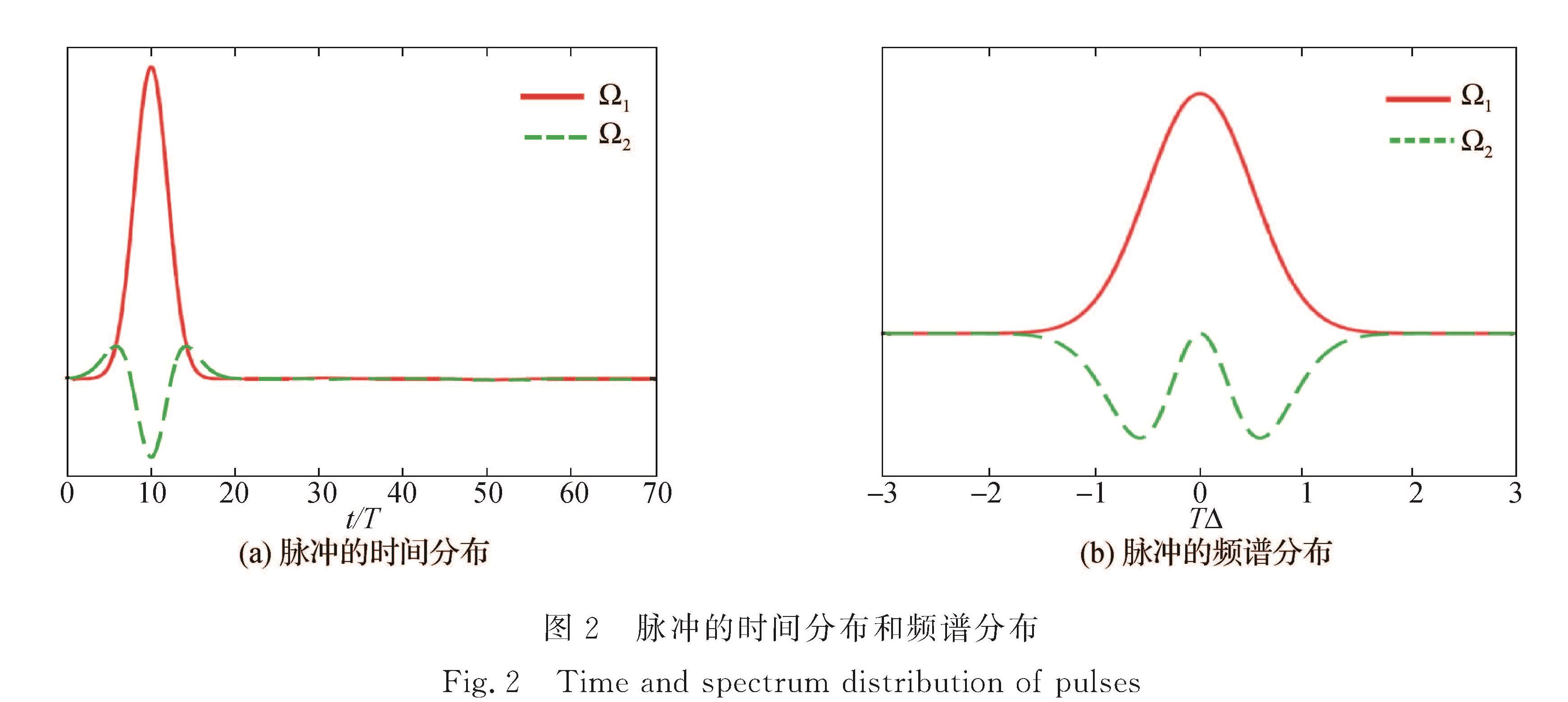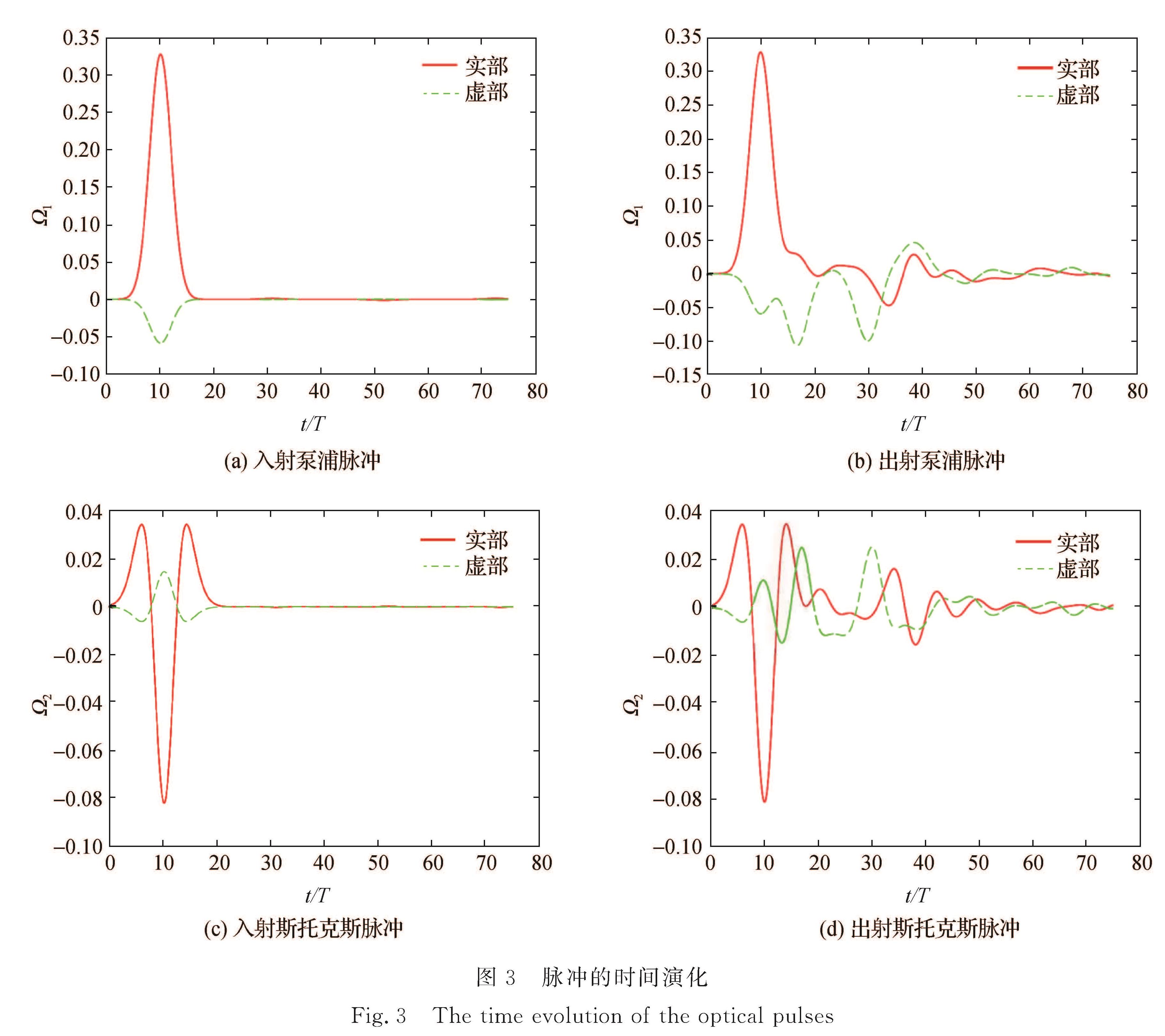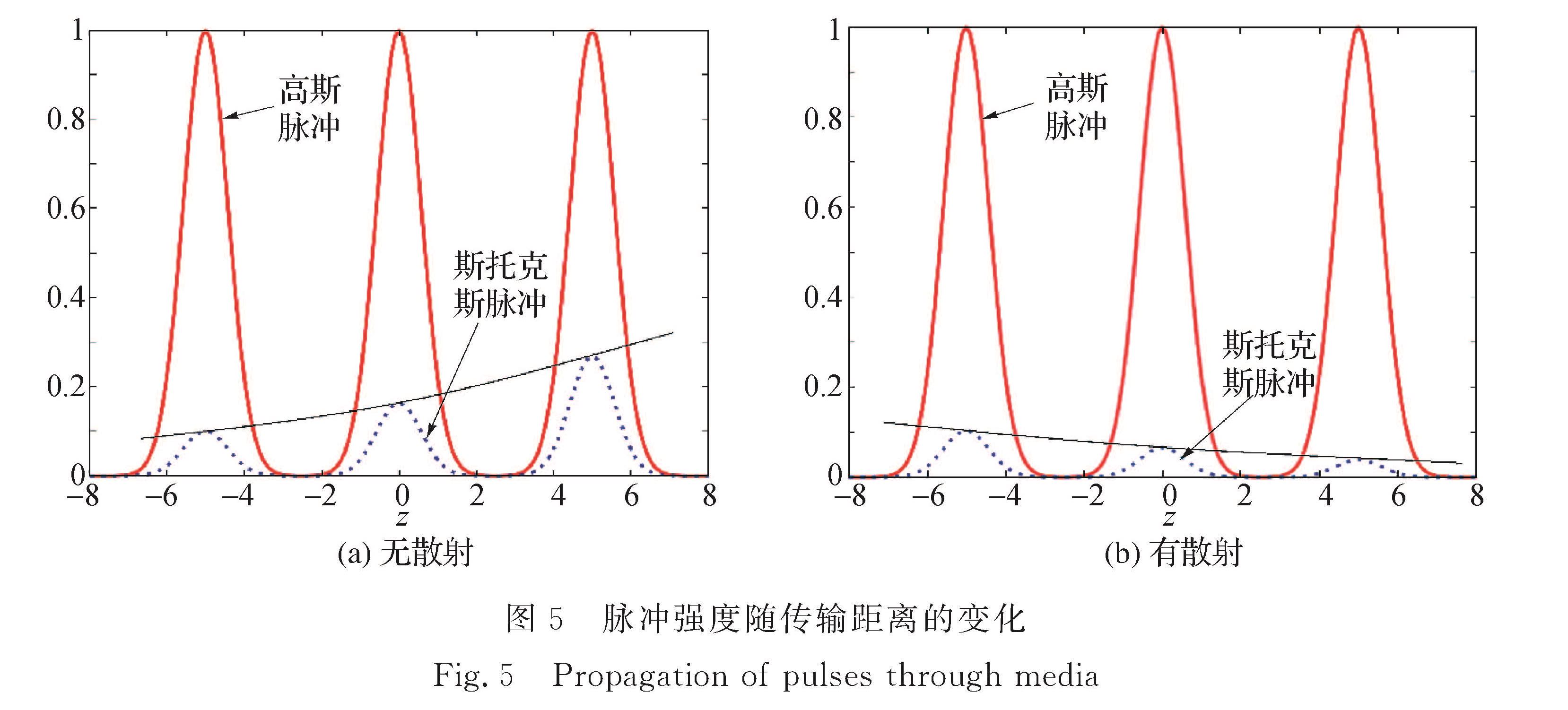< br/>通信作者:sundong@xmut.edu.cn < br/>
(1.厦门理工学院光电与通信工程学院,福建省光电技术与器件重点实验室(厦门理工学院),福建 厦门 361024; 2.北德州大学物理系,北德州大学非线性科学中心,德克萨斯州,登顿TX 76203)
(1.Fujian Provincial Key Laboratory of Optoelectronic Technology and Devices,School of Optoelectronic andCommunication Engineering,Xiamen University of echnology,Xiamen 361024,China; 2.Center for Nonlinear Sciences,Department of Physics,University of North Texas,Denton,TX 76203,USA)
stimulated Raman spectroscopy; quantum coherence; pulse shaping; discrete-dipole approximation
DOI: 10.6043/j.issn.0438-0479.201808001
备注
< br/>通信作者:sundong@xmut.edu.cn < br/>
拉曼光谱由于具有响应速度快,灵敏度高,不侵入待测物质等特点,近年来在生物和医学检测及成像领域的应用受到了较多的关注.然而,生物活组织往往具有较强的散射特性,影响受激拉曼光谱的成像质量.为了提高受激拉曼光谱的成像质量,引入脉冲波形技术,采用对拉曼散射具有较高敏感性的0π脉冲为斯托克斯脉冲,利用离散偶极矩近似方法,对强散射介质中的脉冲传输进行数值模拟.研究发现:在多次散射的作用下,尽管激光脉冲强度随着其在介质中的传输距离增大而衰减,但受益于0π脉冲的特性,输出信号在双光子共振时的强度将增强2倍左右,为提高强散射介质中的受激拉曼光谱质量提供了一个新的可能.
Due to its fast response,high sensitivity,and non-intrusion into the sample,the application of Raman spectroscopy in the biological and medical detection and imaging fields has received much attention in recent years.However,biological living tissues usually exhibit high scattering characteristics,which greatly limit the imaging quality of stimulated Raman spectroscopy.To improve the imaging quality,we study the propagation of pulses and stimulated Raman spectroscopy process in strong scattering media by using the pulse shaping technique and discrete dipole moment approximation method,in which a 0-pi pulse with high sensitivity to Raman scattering is adopted as Stokes pulse.It is found that under the influence of multiple scattering,the pulse intensity decreases with the increase of its propagation distance in the media.Benefiting from these characteristics of 0π pulse,the intensity of output signal in two-photon resonance increases by approximately three times,providing a possible way to improve the imaging quality of stimulated Raman spectroscopy in strong scattering media.
引言
拉曼光谱[1]是一种非常强大的工具,利用待测物质内的原子分子能级共振,可以获取物质的成分和化学结构等信息,在化学和生物等领域有着广泛的应用.特别是在生物活组织检测上,如细菌孢子识别[2-4]、血糖监测[5]、癌细胞识别[6]等,拉曼光谱不需要侵入待测物质,而且测量速度快,安全性高,具有巨大的应用潜力.生物活组织、细菌孢子等介质,内部结构比较复杂,存在显著的颗粒不均匀性,对光子有比较显著的散射作用,即所谓的强散射介质.拉曼光谱对待测样品和环境的变化极其敏感,强散射介质中的多次散射的影响,将造成拉曼光谱的测量精度显著下降.然而,常规的拉曼散射属于自发辐射,散射效率较低且斯托克斯/反斯托克斯散射光为非相干光.在一定条件下,当强激光入射某些介质时,其散射效率会大幅度的提高,散射光成为相干辐射,且具有较好的方向性和单色性,从而提高了拉曼光谱的测量精度,这就是所谓的受激拉曼光谱.
为进一步提高受激拉曼光谱特征信号的对比度,降低背景噪声,傅里叶变换、小波变换[7]等方法被广泛应用于数据处理.实验上,通过多次应用受激拉曼光谱显微镜振动成像技术[8],以及在拉曼频宽内分波段测量[9],也可显著地提高受激拉曼光谱的信号和噪声对比度.此外,未经多次散射的拉曼特光谱征信号相比于经历多次散射的信号和噪声,可以更早的被接收到.利用时间门控技术[10],只接收最早透射出介质的部分信号,也可以获得更好的信噪比.
以上方法虽然可以提高受激拉曼光谱的信号质量,但不论是从数据的处理还是从实验设计上都是将散射信号作为背景噪声予以一定的过滤和压制.同时,分区分波段等处理方式也降低了拉曼光谱分析的响应速度和透射信号强度.而事实上,强散射介质对光信号的多次散射,不但改变了入射光信号的强度,也对新产生的受激拉曼散射(SRS)特征信号有着不可忽视的调制作用.背景噪声信号也携带了介质的部分信息,但由于其受散射介质的结构成分等影响较大,相关的研究工作较少.
近年来,脉冲整形技术[11-12]获得了广泛的关注,脉冲波形及相位在光与物质相互作用过程中的作用得到了深入的研究.本研究将该技术应用于SRS过程中,使用离散偶极近似法(DDA)[13],对强散射介质中的受激拉曼光谱、脉冲的传输和多次散射过程进行了仿真研究.
1 理论模型
SRS能级系统的结构如图1所示.考虑一个同时与2个激光脉冲相互作用的具有Λ形的3能级结构分子气体系统,其中能级b为基态,能级a和c为激发态.频率为ν1的泵浦激光脉冲∈1耦合了能级a和b,频率为ν2的斯托克斯脉冲∈2作用在能级a和c间的跃迁上.在泵浦脉冲光子和斯托克斯脉冲光子的共同作用下,介质从基态受激吸收到高能级a,再经受激辐射跃迁至能级c.泵浦脉冲和斯托克斯脉冲与介质的相互作用激发电偶极子跃迁,它们的拉比频率分别为Ω1=μab·∈1)/(h)和Ω2=(μac·∈2)/(h).μ是电偶极子的电偶极矩.由于双光子共振时,SRS效应显著,因此两脉冲的频率差,与待测分子的振动能级b、c间的跃迁频率失谐Δ越小越好.
泵浦激光脉冲为经典的高斯脉冲,其拉比频率由Ω1(t)=Ω10exp(-t2T -2))给出,Ω10为Ω1的最大振幅.斯托克斯脉冲比较特殊,由脉冲整形技术构造,其波形的面积积分为零,拉比频率可写为Ω2(t)=Ω20[exp(-(t2)/(T2))-T/(T2)exp(-(t2)/(T22))],(1)其中:T和T2是脉冲的波形包络参数,具有时间量纲; Ω20为Ω2的最大振幅.由于该脉冲的面积,即脉冲波幅的时间积分为零,也被称为0π脉冲.根据二能级介质中的面积定理[14],0π脉冲的面积也为π的整数倍,因此可在介质中传播更长距离,且该特性对增强多次散射介质的信号可能有益.计算可得相应的脉冲光谱分布函数:fΩ2(ω)=∫e-iω tΩ2(t)dt=(π)1/2Ω20T[exp(-T2ω2/4)-exp(-T22ω2/4)].(2)泵浦脉冲与斯托克斯脉冲的时间分布及频谱分布如图2所示.其中实线是泵浦脉冲为常规的高斯脉冲,而斯托克斯脉冲(虚线)则为特殊的0π波形.在数值计算中,总是可以通过选择适当的Ω10,使符合SRS能量阈值条件的泵浦脉冲的入射能量归一化为1.此时,时间变量t和失谐频率Δ可相应地改写为t/T和TΔ,从而使变量成为无量纲参量,便于后续数据处理.该斯托克斯脉冲的一个重要特征在于其频谱分布中存在一个中心频率ω=0的频谱 “孔”,如图2(b)虚线所示.由于SRS是非线性效应,脉冲在时间分布上强度不同的部分受到的SRS的作用程度也不同,脉冲波形将改变,连带改变了脉冲的频谱分布.根据以上分析,0π脉冲的频谱“孔”在介质中将会由于非线性的SRS效应而被部分的填充.故检测“孔”填充程度,可获得参与SRS过程的特定分子的光谱信号[15-16].
脉冲的波形在光与物质的相干作用过程中以及物质的激发过程中起着重要的作用.0π脉冲由于其波形的特殊性,很难直接由激光器产生.实验上较常使用非线性的空间光调制器(SLM)来进行脉冲波形控
制,如Boulder的非线性液晶SLM系统,也可利用光折变多量子阱中的动态全息技术[17].这两大类方法,均可实现对脉冲的波形、强度、相位的实时调整和控制.图1所示系统的相互作用哈密顿量可写为:VI=-h[Ω1e-iωabt|φa〉〈φb|+Ω2eiωact|φc〉〈φa|+H.c.],(3)其中,ωab和ωac是能级ab、ac间的振动频率,φa、φb、φc分别为能级a、b、c的态函数,H.c.是式(3)厄米共轭部分.初始状态下的所有粒子均在b能级.求解式(3),可得密度矩阵元素的时间演化方程:ρ ·ab=-ΓabρabiΩ1-iρcbΩ*2,ρ ca=-Γcaρca+iρcbΩ*1,(4)ρ ·cb=-Γcbρcb-iΩ2ρab+iΩ1ρca,其中:Γab=γab+i(ωab-ν1),Γca=γac-i(ωac-ν2),Γcb=γcb+i(ωcb-ν1+ν2)分别为相应相干项的弛豫速率; γac为能级a和c之间的自发辐射速率; ν1,2是入射脉冲的频率,Ω*α是拉比频率Ωα的复共轭(α=1,2); ρab,ρca,ρcb为粒子数密度矩阵的元素.考虑脉冲频率与三能级系统的双光子跃迁共振,即ωab?ν1和ωac?ν2,引入双光子失谐Δ=ωcb-ν1+ν2.由于激光脉冲的持续时间T比光学极化的弛豫时间长,但比振动相干的弛豫时间短,则相干项ρcb的演化方程可改写为ρ ·cb=-Γ~cb-Ω1Ω2Γab-1,其中Γ~cb=Γcb+|Ω2|2Γab-1+|Ω1|2Γca-1.对于短光学脉冲,Γ ~cbT1,可得ρcb=-∫t_∞Ω1(t')Ω2(t')Γab-1dt'.斯托克斯脉冲的波形受相干过程的影响,由于其相干项ρca=iρcbΩ*1Γca-1,故脉冲Ω1波形随时间的分布也起着关键作用.相应的光偶极矩=μacρac对散射场的贡献为E2=c2∑{( ··r2-r(r· ··)+c2 ··+cr ··)r-3-3(r[r·(c2+cr·)])/(r5)},(5)其中,c是光速,r为气体中分子的位置,求和将遍历所有分子.斯托克斯脉冲的拉比频率由脉冲与分子的非相干散射部分和相干拉曼散射部分构成.在后续的计算过程中,不进行滤波等处理.Ω2(r)=ΩB2(r)+ΩR2(r),(6)其中,ΩB2(r)是与介质的非相干散射,ΩR2(r)是脉冲与分子的相干散射.Ω2的频谱分量可定义为fΩ2(ω,r)=-∫Ω2(t,r)eiωtdt,(7)则其相干散射的部分的频谱分量为fRΩ2(ω,r)=-Γ-1ca∫ρcbΩ*1(t,r)eiω tdt,(8)从式(8)中可以看出,fΩ2是ρωcb和Ω*1的卷积.因此,若入射脉冲Ω2在最初存在频谱分布fB</sub>Ω2(r=0)=0的 “孔”,由于介质的相干散射fBΩ2的作用,该“孔”将被逐步的填满.若检测“孔”填充程度,可用于判定作用于特定分子的SRS效应的强度.斯托克斯场的归一化零频分量信号的定义式为S2≡fΩ2(r)(Ω20T)-1,则输出信号为:S2=(ΓabΓcaΩ20T)-1∫∞_∞Ω*1(t)eiω tdt∫t_∞Ω1(t')Ω2(t')dt'.由于入射脉冲的孔位于ω=0的频率上,带入可得,S2=(ηLT|Ω10|2)/(ΓabΓca)ξ(ηLT|Ω10|2)/(ΓabΓca),(9)其中,ξ=∫∞_∞(dt)/(T)(Ω*1(t))/(Ω*10)∫t_∞(Ω1(t')Ω2(t'))/(Ω10Ω20)1/Tdt',取决于脉冲的形状,且0<ξ≤1.2 数值仿真
介质中的多次SRS过程的仿真需要对一组包含3能级系统的密度矩阵的时间演化方程和麦克斯韦方程的自洽方程组求解.其中的麦克斯韦方程,用于描述脉冲在介质中的传播特性.一般来说,在结构比较均匀的常规介质中,麦克斯韦方程可以退化为电磁场的输运方程(?Ωα)/(?z)=-καΩα-iηαρα,(10)其中:α=1时,式(10)为泵浦激光脉冲的输运方程,ρα=ρab; α=2时,式(10)为斯托克斯脉冲的输运方程,ρα=ρac; ηα是与介质密度有关的耦合常数; z是传输距离; κα是细胞中散射、衍射或非共振吸收引起损耗系数.输运方程的可靠性和准确性在理想的原子分子气体[15]以及密度较高具有较强散射效应的原子分子气体[16]中都已经得到了较好的验证.
而生物活组织等介质,其内部结构和成分往往具有显著的颗粒不均匀性,式(10)中的损耗系数等参数很难获得确定值.因此,涉及散射介质的麦克斯韦方程的求解需要利用离散偶极近似法(DDA),这也是求解麦克斯韦方程的一种精度较好的近似方法.
DDA方法将连续介质表示为有限个“点”的阵列,这些“点”作为在电场存在下辐射的点偶极子,从而可以对任意几何结构的介质进行模拟[13],研究分子聚集体的光学性质.为了获得完整的散射电场,介质中所有点偶极子的自相关方程组都必须求解.假设介质由N个点偶极子构成,j=1,2,…,N代表第j个偶极子,αj是点阵中位置rj处的极化率.
第j个偶极子的极化由下式给:Pj=αjEj,(11)其中Ej表示在入射电场Einc,j=E0ei(k·rj-ωt)的作用下偶极子在点rj处的电场.剩余的N-1偶极子对电场贡献为:Ej=Einc,j-∑{m≠j}AjmPm,(12)其中AjmPm是由位于rm处的点偶极子在点rj处产生的电场,已包含了延迟效应.Ajm是对应于每个点偶极子的3x3的矩阵,Ajm=eikrjmr-1jm(k2((rj-rm)(rj-rm)r-2jm-I)+(ikrjm-1)r-2jm(3(rj-rm)(rj-rm)r-2jm-I)),(13)其中:k=ωc-1,c为光速; rjm=|rj-rm|; I是3x3的单位矩阵.如果定义Ajj=α-1j,只需要找到满足下面线性方程组的极化Pj:∑Nm=1AjmPm=Einc,j.(14)通过数值求解式(14)获得满足方程的极化,就可以计算出散射场的分布,并根据式(8)求得相应的拉比频率分布,数值仿真结果如图3所示.利用DDA法求得自相关方程组的解,从而得到通过介质前后泵浦脉冲及斯托克斯脉冲的拉比频率随时间的演化.图3中,实线是脉冲的实部演化过程,虚线是脉冲的虚部演化过程.通过对比介质前后的脉冲波形,可清晰的观察到,多次散射显著的改变了脉冲波形的时间分布.由于0π脉冲的频谱“孔”,对应着波形时间分布的面积为0.由数值仿真结果可知,0π脉冲的面积在传输过程中不断变化,因而其“孔”将被逐步的填充.由式(9)可知,输出介质的信号S主要取决于两入射脉冲的拉比频率以及相干项的弛豫速率.介质中的多次散射改变了输出脉冲的波形,因此输出信号的强度分布也随之改变.SRS是双光子共振过程,对于给定的系统,失谐(Δ)越小相干度越高.图4所示为不同失谐下的输出信号分布.其中虚线是进入介质前的脉冲信号强度,实线是输出脉冲信号的强度.当双光子共振程度较低时(Δ较大的两端),输入输出信号的分布几乎相同,拉曼散射的作用几乎可以忽略.当接近于双光子共振时(Δ失谐较小),散射信号增强到输入信号的2倍多,这将显著提高SRS的信噪比.输出信号得到增强的失谐范围较窄,也有利于提高待测分子成分的判断精度.同时也必须注意到,受到介质多次散射的作用,泵浦激光脉冲和斯托克斯脉冲的强度在传输过程中会发生衰减.这一结论可由图5所得,图5所示是高斯脉冲和斯托克斯脉冲的强度随其在介质中的传输距离的变化,实线为高斯脉冲,虚线为斯托克斯脉冲.图5(a)是无多次散射的模拟结果,高斯脉冲的强度不变,可归一化处理,作为强度参照使用.由于拉曼放大的作用,相应的斯托克斯脉冲得以逐渐增强.图5(b)是存在多次散射的结果.多次散射导致高斯脉冲和斯托克斯脉冲的强度均显著的衰减.为了与无散射情况 对比,以高斯脉冲的强度为参照做归一化处理.多次散射的作用,抵消了拉曼放大的作用,削弱了斯托克斯脉冲的强度,以及相应的输出信号强度.3 结 论
本研究提出了一种提高强散射介质中受激拉曼光谱特征信号强度的方法,可增强输出信号的信噪比.利用脉冲整形技术,以0π脉冲作为探光,对强散射介质中的多次散射过程进行了探索和仿真.由于0π脉冲具有波形较为复杂,面积为零能量不为零的特性,其在传输过程中更易受拉曼散射的非线性效应影响,从而可以通过其波形的频谱调制变化量,来衡量散射作用的强弱.该方法不仅限于SRS,还可广泛应用在相干反斯托克斯拉曼光谱(CARS)、四波混频(four-wave mixing)等相干拉曼光谱的研究中[16].
与采用式(10)输运方程进行模拟[16]相比,使用DDA对多次散射过程的模拟更加的精确.研究发现,在多次散射的作用下,输出信号在失谐Δ较小的情况下(双光子共振附近),输出信号得到了约2倍的增强.这对提高强散射介质中的受激拉曼光谱信噪比,提高强散射介质的物质成分识别准确度,有一定的参考价值.
致谢:感谢Nikolai Kalugin,Jos Odeurs,Paolo Grigolini和Vladimir Sautenkov等对本研究的启发性讨论和建议,Rostovtsev感谢北德州大学先进材料与制造过程研究所的支持.
- [1] SCHRADER E B.Infrared and Raman spectroscopy[M].Tokyo:VCH,1995:465.
- [2] SCULLY M O,KATTAWAR G W,LUCHT B P,et al.FAST CARS:engineering a laser spectroscopic technique for rapid identification of bacterial spores[J].Proc Nat Acad Sci USA,2002,99(17):10994-11001.
- [3] PESTOV D,ZHI M C,SARIYANNI Z E,et al.Visible and UV coherent Raman spectroscopy of dipicolinic acid[J].Proc Nat Acad Sci USA,2005,102(42):14976-14981.
- [4] PESTOV D,MURAWSKI R K,ARIUNBOLD G O,et al.Optimizing the laser pulse configuration for coherent Raman spectroscopy[J].Science,2007,316(5822):265-268.
- [5] PANDEY R,PAIDI S,VALDEZ T,et al.Noninvasive monitoring of blood glucose with Raman spectroscopy[J].Acc Chem Res,2017,50(2):264-272.
- [6] OSELEDCHYK A,ANDREOU C,WALL M A,et al.Folate-targeted surface-enhanced resonance Raman scattering nanoprobe ratiometry for detection of microscopic ovarian cancer[J].ACS Nano,2017,11(2):1488-1497.
- [7] SCHULZE G,JIRASEK A,YU M,et al.Investigation of selected baseline removal techniques as candidates for automated implementation[J].Appl Spectrosc,2005,59(5):545-574.
- [8] LIAO C S,SLIPCHNKO M N,WANG P,et al.Microsecond scale vibrational spectroscopic imaging by multiplex stimulated Raman scattering microscopy[J].Light:Sci Appl,2015,4:e265.
- [9] SUHALIM J L,CHUNG C Y,LILLEDAHL M B,et al.Characterization of cholesterol crystals in atherosclerotic plaques using stimulated Raman scattering and second-harmonic generation microscopy[J].Biophysical Journal,2012,102(8):1988-1995.
- [10] DUNCAN M D,Mahon R,TANKERSLEY L L,et al.Time-gated imaging through scattering media using stimulated Raman amplification[J].Optics Letters,1991,16(23):1868-1870.
- [11] MONMAYRANT A,WEBER S,CHATEL B.Anewcomer's guide to ultra-short pulse shaping and characterization[J].Political Science Quarterly,2010,43(10):759-775.
- [12] WEINER A M.Femto-second pulse shaping using spatial light modulators[J].Rev Scient Instru,2000,71(5):1929-1960.
- [13] DRAINE B T,FLATAU P J.Discrete-dipole approximation for scattering calculations[J].J Opt Soc Am A,1994,11(4):1491-1499.
- [14] ALLEN L,EBERLY J H.Optical resonance and two level atoms[M].New York:Dover,1987:72.
- [15] SUN D,SARIYANNI Z E,DAS S,et al.Propagation of 0π pulses in a gas of three-level atoms[J].Phys Rev A,2011,83(6):063815.
- [16] SARIYANNI Z E,SUN D,ROSTOVTSEV Y V.Stimulated Raman spectroscopy with 0π pulses[J].Opt Lett,2014,39(4):766-768.
- [17] DING Y,BRUBAKER R M,NOLTE D D,et al.Femtosecond pulse shaping by dynamic holograms in photorefractive multiple quantum wells[J].Optics Letters,1997,22(10):718-720.





